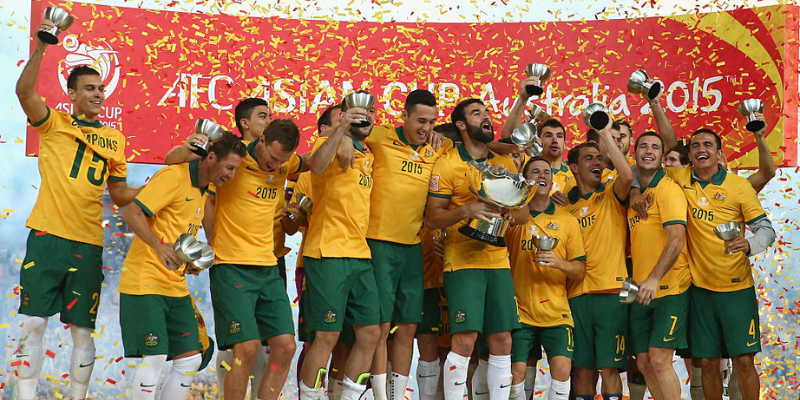They’re called the Socceroos, but how did Australia’s national football team come to adopt that name? In a country where rugby, Aussie rules, and cricket often steal the spotlight, the moniker Socceroos is more than a tag—it’s a symbol of identity, pride, and evolution. In this article, MantaBall will accompany you to explore the origin, adoption, meaning, controversies, and enduring legacy behind why is Australia’s national team nicknamed Socceroos.
The early days of Australian soccer

Long before the name Socceroos entered the lexicon, Australia’s national men’s team played under more mundane titles—“Australia,” “Australia XI,” or “the national side.” The first official match dates back to June 1922 in Dunedin, New Zealand, where Australia lost 3-1. Over decades, media and fans simply referred to “Australia” or “the national soccer team,” with no distinct branding.
Australia’s football history in the mid-20th century was one of struggle: lack of funding, meager media attention, and a battle for public recognition amid dominance of other football codes. It wasn’t until the 1960s that soccer began carving its modern identity—and with it, the need for a memorable nickname.
How the name Socceroos emerged

Tony Horstead’s coinage
The most widely accepted origin story credits Sydney journalist Tony Horstead, who in 1967 coined Socceroos during the national team’s goodwill tour to South Vietnam. He combined “soccer” and “kangaroos” to form a catchy, uniquely Australian name. The kangaroo is a national icon, and pairing it with “soccer” gave the team a distinctive brand that echoed existing Australian team names (e.g. Wallabies, Kangaroos). Over time, media outlets adopted it, and fans embraced it.
But this narrative isn’t without debate. Some accounts suggest that Horstead’s use was sporadic at first, and that the name gained traction gradually in the early 1970s. Others argue that the name “Socceroo” may have been used initially as a mascot name around the 1974 World Cup buildup.
Alternate claims and myths
Several alternate origin stories also circulate:
- Some suggest the term emerged in 1971, ahead of a later Vietnam tour, contrary to 1967 claims.
- Others point to media logbooks or badge designs in the early 1970s attributing the name to anonymous sportswriters or photographers.
- A linguistic historian has argued that earlier documented appearances of “Socceroo” date, most football historians and the governing body treat Tony Horstead’s 1967 coinage as the origin point, with the name entering widespread usage by the early 1970s.
Why Socceroos resonated—and stuck

Native symbolism and branding
Australia’s national teams often use animal-inspired nicknames: the Kangaroos in rugby league, Wallabies in rugby union, Boomers in basketball, etc. Socceroos fit this tradition—adding “-roos” to a sport term aligned with local identity. The kangaroo instantly evokes Australia in global eyes, and combining it with soccer created a name easy to remember, chant, and market.
It also embraced an Australian linguistic habit—creating colloquial portmanteaus and playful monikers—and filled a branding void in a sport seeking a distinctive identity in a crowded sporting landscape.
The rise through tournaments
By 1974, during Australia’s first FIFA World Cup qualifying campaigns, the name Socceroos was being used in print without explanation—an indicator that it had already entered popular vocabulary. The team’s exposure on the world stage helped cement the name in the public’s mind., and official channels embraced “Socceroos.” Over decades, it became inseparable from the Australian national men’s football team identity.
Sociolinguistic and cultural meaning
A statement of distinct sporting identity
For many Australians, Socceroos represents more than a nickname—it’s an assertion that soccer belongs in the Australian sporting fabric. In a country where “football” more often refers to AFL or rugby codes, Socceroos signals that association football has its place.
Bridging “soccer” vs “football” debate
Australia’s use of the term “soccer” (versus “football”) has long been debated. By embedding “soccer” into the national team’s name, the nickname acknowledges the historical linguistic reality. Over time, as the sport’s branding shifted toward “football,” many embraced Socceroos as a heritage name that resisted wholesale renaming—even when policy sought to emphasize “football” over “soccer.”
Emotional resonance with fans
Nicknames humanize teams. When fans chant “Let’s go, Socceroos!” they address something more than Australia—they support an entity with personality. The term draws emotional connection: identity, pride, nostalgia, and unity across generations.
Modern usage, sponsorships, and controversies
In recent years, the Socceroos name has carried commercial weight. The national team carries naming-rights branding (e.g. commercial sponsor prefixes), but the core “Socceroos” remains central.
At times, debates have surfaced about whether to drop “Soccer” and replace with “Football Roos” as part of rebranding toward “football.” But these proposals met resistance: fans see “Socceroos” as iconic and part of tradition. The governing body has affirmed its intention to retain the name while evolving overall branding.
Socceroos in numbers: records, stats, and legacy
- Australia’s team nickname is Socceroos.
- Their most capped player is Mark Schwarzer (109 caps).
- Their top scorer is Tim Cahill.
- Their largest recorded win is 31–0 vs American Samoa (2001), a world record in senior internationals.
- They first qualified for a FIFA World Cup in 1974, and regularly since 2006.
- The women’s team, once semi-derivatively called “Female Socceroos,” now use Matildas—a separate identity built in the 1990s.
Why the nickname matters today
The fact that we still ask why is Australia’s national team nicknamed Socceroos underlines its staying power. That name bridged early struggles, branding challenges, debates over terminology, and changing football landscapes. It’s not just a label—it’s a core part of how Australia tells its football story, domestically and globally.
Today, when you see the Socceroos stride onto the field—green and gold, kangaroo-inspired emblem blazing—you’re not just looking at a team. You’re seeing a cultural emblem born of media invention, national symbol, and fan devotion.
Final Thoughts
Why is Australia’s national team nicknamed Socceroos? Because a Sydney journalist dared to invent a name in 1967, combining soccer and kangaroos into something memorable, and over time it became woven into Australia’s sporting fabric. The name resonated: symbolic, catchy, uniquely Australian—and it stuck.
MantaBall hopes you now understand the origin, meaning, and legacy behind the Socceroos name. If you’re curious, next explore how the Matildas got their name or compare other national team nicknames across the world. Stay tuned, and keep supporting the beautiful game!
